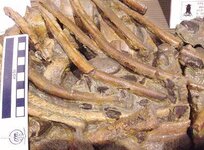- Joined
- Nov 19, 2002
- Messages
- 3,031
These images depict a very unusual cephalopod discovery; this particular cephalopod, as far as I have been able to determine, represents the only known fossils of an ancient relative of the Vampire Squid, Provampyroteuthis giganteus. The fossil depicts a partial ribcage and stomach contents (including gastroliths) of a hitherto undescribed elasmosaurid plesiosaur (1998). The fossil dates to the early Santonian of the Late Cretaceous period, (approx. 87-85 mya ) was found at Hokkaido, Japan and is currently housed at the Yokasuka City Museum.
The black wedge shapes clearly visible between the ribs represent upper and lower jaw apparatus of this ancient vampyromorph. Interestingly, the upper jaws have been reported as bearing a striking similarity to the modern Vampyroteuthis infernalis and other octopods yet the lower jaw is more nautiloid in form. Major differences with Vampyroteuthis are that of size, Provampyroteuthis being considerably larger, and that of environment. Vampyroteuthis currently lives at a depth of 300-2500m whereas the Provampyroteuthis must have lived at a much shallower depth as it thought that the plesiosaurs were surface or shallow water swimmers and it is believed that these fossils came from an off-estuary deposit.
Perhaps we are looking at a scenario whereby the close relatives of Vampyroteuthis were, at least in some areas of the world, larger, more powerful surface swimmers that were slowly driven to the depths of the deeper parts of the ocean in the late Cretaceous or early Tertiary period. Today their descendants survive as smaller and weakly muscled ‘living fossils’.
Thanks to Mike Everhart for the photos.
The black wedge shapes clearly visible between the ribs represent upper and lower jaw apparatus of this ancient vampyromorph. Interestingly, the upper jaws have been reported as bearing a striking similarity to the modern Vampyroteuthis infernalis and other octopods yet the lower jaw is more nautiloid in form. Major differences with Vampyroteuthis are that of size, Provampyroteuthis being considerably larger, and that of environment. Vampyroteuthis currently lives at a depth of 300-2500m whereas the Provampyroteuthis must have lived at a much shallower depth as it thought that the plesiosaurs were surface or shallow water swimmers and it is believed that these fossils came from an off-estuary deposit.
Perhaps we are looking at a scenario whereby the close relatives of Vampyroteuthis were, at least in some areas of the world, larger, more powerful surface swimmers that were slowly driven to the depths of the deeper parts of the ocean in the late Cretaceous or early Tertiary period. Today their descendants survive as smaller and weakly muscled ‘living fossils’.
Thanks to Mike Everhart for the photos.




 it seems to me that elasmosaurs would have hunted by purely visual methods, unlike the Sperm Whale which probably uses echo-sounding to locate large squid or shoals of squid. It is interesting that the eyes on elasmosaurid plesiosaurs were located angled slightly upwards on top of the skull and the fact that many examples, including this one, contained stones as part of the gut contents. These gastroliths were believed to have worked as counterbalance to create neutral buoyancy during dives. There is also evidence that some plesiosaurs suffered from ‘avascular necrosis’ in the humeri and femora, this being a form of bone death that is brought on by the interruption of blood flow as part of decompression sickness (5% of 576 specimens in a recent study published in the Journal of Vertebrate Paleontology).
it seems to me that elasmosaurs would have hunted by purely visual methods, unlike the Sperm Whale which probably uses echo-sounding to locate large squid or shoals of squid. It is interesting that the eyes on elasmosaurid plesiosaurs were located angled slightly upwards on top of the skull and the fact that many examples, including this one, contained stones as part of the gut contents. These gastroliths were believed to have worked as counterbalance to create neutral buoyancy during dives. There is also evidence that some plesiosaurs suffered from ‘avascular necrosis’ in the humeri and femora, this being a form of bone death that is brought on by the interruption of blood flow as part of decompression sickness (5% of 576 specimens in a recent study published in the Journal of Vertebrate Paleontology).